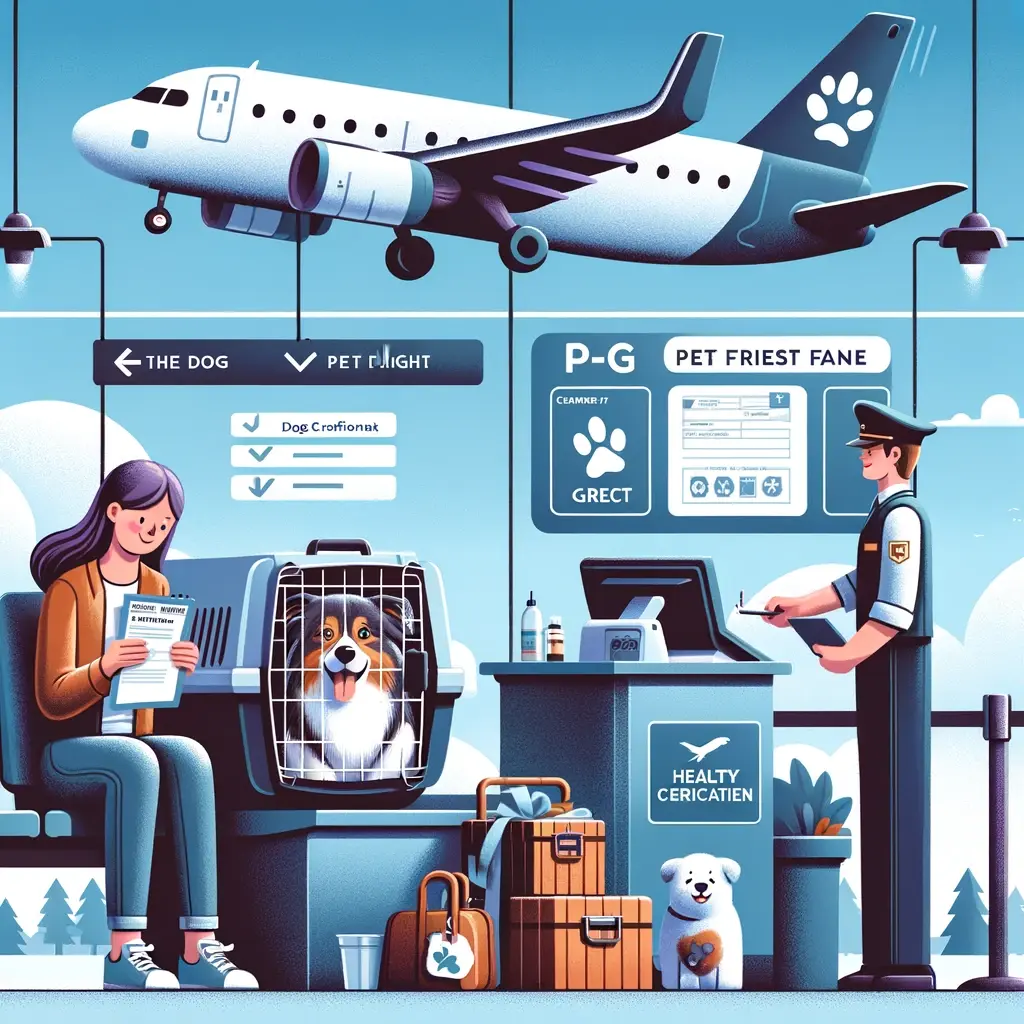How to Fly with a Dog? You love your dog dearly, and your dog loves you too. So there’s no reason why your four-legged friend should be left behind while you travel overseas.
Flying with Your Dog: A Comprehensive Guide
Flying with your furry friend requires careful planning and consideration. Here’s a breakdown of everything you need to know for a smooth journey:
Before You Book
- Is Flying Necessary? Consider if flying is truly the best option for your dog. Long flights and cargo travel can be stressful. Alternatives like pet-sitters or boarding facilities might be a better fit.
- Breed Restrictions: Many airlines restrict snub-nosed breeds (like Pugs or Bulldogs) due to breathing difficulties in cargo. Check with your airline.
- Airline Policies: Research each airline’s specific pet policies regarding carrier size, fees, and in-cabin vs. cargo regulations.
- Destination Requirements: If traveling internationally, research your destination’s animal import laws and potential quarantine periods.
Preparing for Your Flight
-
Vet Checkup: Ensure your dog is healthy for travel and obtain a health certificate from your vet. Keep vaccinations up-to-date.
-
Carrier Comfort: Choose an airline-approved carrier that allows your dog to stand and turn comfortably. Familiarize them with the carrier beforehand.
-
Flight Choice: Opt for direct flights and avoid extreme temperatures during travel. Consider early morning or late evening flights for warmer climates.
-
Airline Communication: Contact the airline in advance to reserve a spot for your pet and understand their specific requirements.
-
Medications: Consult your vet about potential anxiety medication, but avoid sedating your dog unless absolutely necessary.
At the Airport
- Arrive Early: Allow ample time for check-in, especially if your dog is traveling in cargo.
- Locate Relief Areas: Familiarize yourself with pet relief areas in both departure and arrival airports.
- Food and Water: Adjust feeding and water schedules based on your vet’s advice.
Upon Arrival
- Pick Up Promptly: Retrieve your dog from the designated cargo area as soon as possible. Airlines have time limits for pickup.
- Immediate Walk: Offer your dog a walk and bathroom break immediately upon arrival.
Key Takeaways:
- Put your dog’s well-being first. Consider their health, temperament, and the necessity of the trip.
- Thorough research and preparation are crucial for a smooth experience.
- Communicate with your airline and veterinarian throughout the process.
- Prioritize your dog’s comfort and safety at all times.
Remember: Flying can be stressful for dogs. By following these guidelines and putting your dog’s needs first, you can make the journey as comfortable and positive as possible.
How to Fly with a Dog?
The size of your dog will tend to determine where in the flight your precious pup is accommodated. Rules can vary from airline to airline. Your dog can fly in the cabin only if it is small enough to fit in the carrier under the seat in front of you.
Any bigger than that, and your dog will be made to travel in the cargo section of the flight along with the luggage and freight.
This is how your precious pet will be shipped. Airlines do tend to try to make flying as pleasant as possible for your pet, but it still is a difficult and strange experience as far as your pet is concerned.
Unless you have no other choice, it is generally best to leave your dog at home with a pet-sitter, friend, or family member. You can also try leaving your pet at a licensed facility.
Precautions to Take While Flying with Your Dog
While flying, your pet may have to be separated from you, which will not be very pleasant for him or her. Additionally, objects may move or fall while traveling with cargo, causing loud scary noises.
Baggage handlers will mainly be concerned about getting everything loaded onto the plane. Amidst that, you cannot expect them to pay any kind of special attention to their pet. There have been instances of pets being injured, falling sick, and even dying after flying with cargo.
Traveling with your pet means choosing the most appropriate pet carrier or crate. According to the International Air Transport Association, there are some basic pet carrier guidelines that most airlines follow.
Your carrier requires to be durable, have plenty of ventilation, strong handles, and a completely leakproof bottom.
It is necessary to mark the carrier with the words ‘Live Animal’. With the help of arrows, you need to indicate which way is up. You will also have to add a label containing your name, contact number, address, and destination contact information.
What is the Cost of Travel for Flying with Your Dog?
You will have to pay approximately $125 one way for your pet to fly in the cabin along with you. This amount can vary from airline to airline.
The cost of shipping your pet in the cargo hold can be calculated using the combined weight of your dog and their crate. Of course, the distance that you are flying is also an important factor. Airlines tend to offer an online calculator through which you can get an estimate of the cost.
Things to Remember While Flying with Your Dog
To make sure that your pet doesn’t get turned away at the last minute, read and review all the rules and guidelines that the airline you are traveling with has for transporting pets. For example, some airlines ban certain breeds.
Breeds such as Pugs and Pitbulls that have snubbed noses are completely banned from the cargo hold as their nose makes it difficult to breathe in such a situation. Pre-check for any such policies.
Choice of Flight
Non-stop flights with no transfers are best suited while traveling with your dog. Also, avoid traveling during holiday periods as much as possible because airports tend to be crowded and chaotic at such times.
While flying your pet in cargo, you need to consider the weather conditions of your destination. If you are traveling to a place that is warm, look for early morning or late evening flights.
For places with a cooler climate, choose flights during the middle of the day. Airlines will not let you fly your pet if the weather conditions get too cold or warm at any place along the way to your destination.
Contact your Airline
There is a set limit to how many dogs any airline allows per flight. Therefore, it is best to call and ensure the plane has space for you and your dog. Make reservations for you and your pet at the same time.
Get Your Dog’s Health Checked
Once you’ve booked the ticket for your pet, go to the vet and get a medical certificate that says the dog is healthy enough to take a flight and also up-to-date on immunizations.
These kinds of certificates are valid only for 30 days. Also, they will be required at the time of your departure as well as your return. So plan your visits to the veterinary clinic in advance
Check Local Animal Importation Laws
In case you are traveling internationally, start checking local animal importation laws as soon as you decide to travel along with your pet.
Some destinations have complicated processes and very long quarantine periods. This could mean you and your pet would be separated throughout your travel.
In addition, some destinations do not allow animals in the cabin, even if your dog is small enough.
Prepare Your Dog
Thoroughly research the departing and arrival airports to make sure you know where exactly the pet relief areas are located. Consult your vet in detail about food, water, and medication for your pet during the trip.
Different people have different opinions when it comes to sedating your pet during the journey. Therefore, you should consult with a vet who is familiar with your dog’s medical history.
Remember that there are health risks associated with the sedation of your pet, and some airports do not accept it or expect a vet’s note. Try to familiarize your dog with the crate or pet carrier in which it is supposed to travel.
You can even take your dog to the airport departure area so that they become comfortable with this new place.
Steps to Follow at the Airport
With a little bit of careful planning, you can ensure that traveling with your dog is hassle-free and pleasant. The following steps are what you need to keep in mind while you are at the airport, both while departing as well as arriving.
- Try and reach the airport early so that you don’t feel rushed.
- If your pet is flying in the cargo section, for a domestic flight, you need to be there 3 hours in advance, and for an international flight, it is 5 hours in advance.
- Check your departure and arrival airport maps well ahead because you might have to take your pet to a separate cargo drop-off section.
What to Do When You Reach Your Destination?
Once you reach your destination, head straight to the cargo location. As a rule, airlines will take care of your dog for up to two hours once the flight has arrived. Also, they have to be picked up within four hours, or they will be taken to a vet or boarding facility.
Take your dog for a walk right away, irrespective of how your dog flew. Stretch your legs and stretch those of your dog too.
All of the above listed are merely guidelines on how to fly hassle-free with your pet dog. They apply to any airline that you choose to fly with. Every airline has certain policies, certain arrangements, and also some reservations.
So you must do a bit of homework. Do not assume anything. Contact the airline and make inquiries on what policies they follow when it comes to traveling with pets. Then, plan your time at the airport accordingly.
The process of traveling with your pet may be complicated, but when you think about how much fun it is to travel with him/her, you know it’s worth the trouble.








